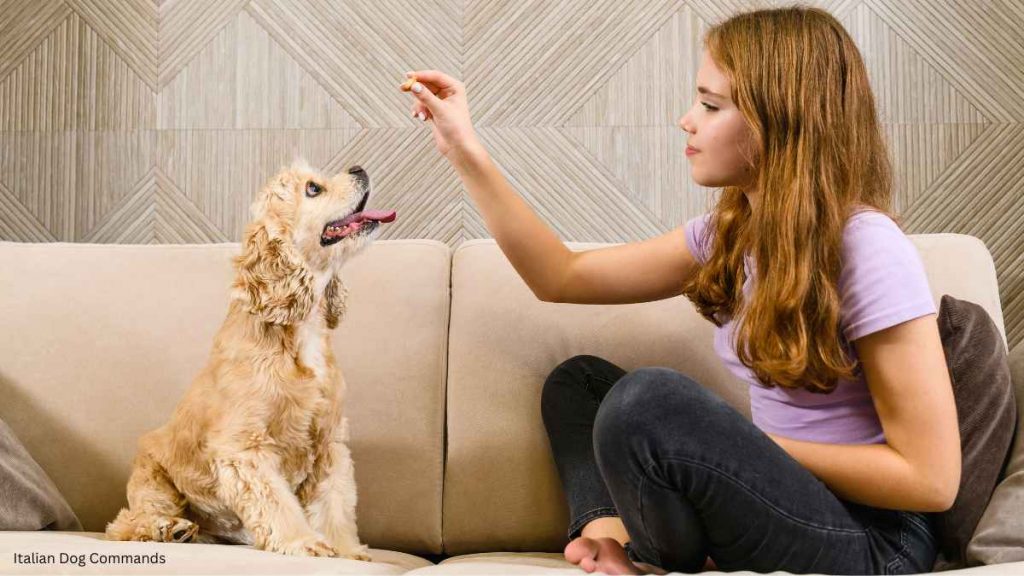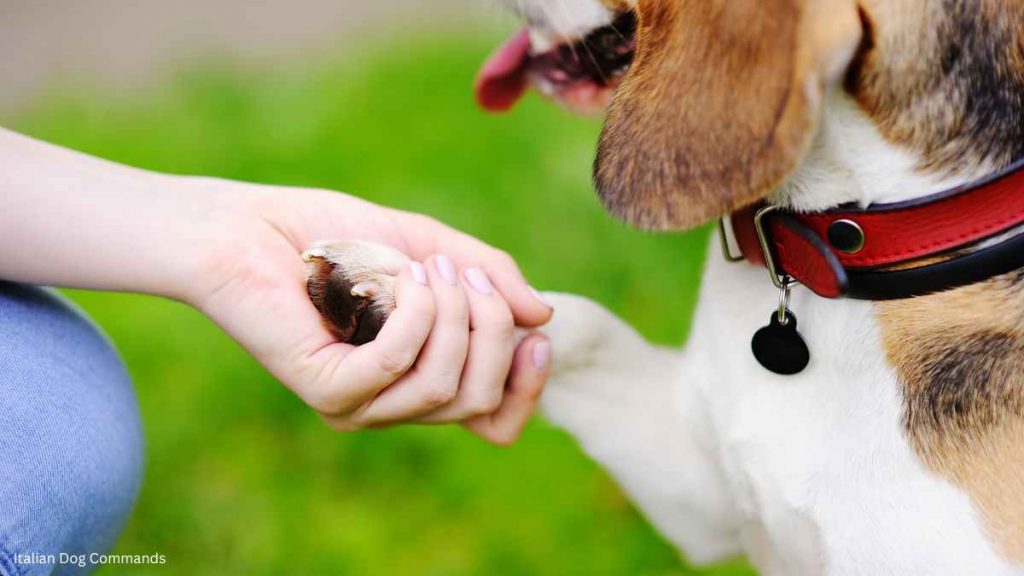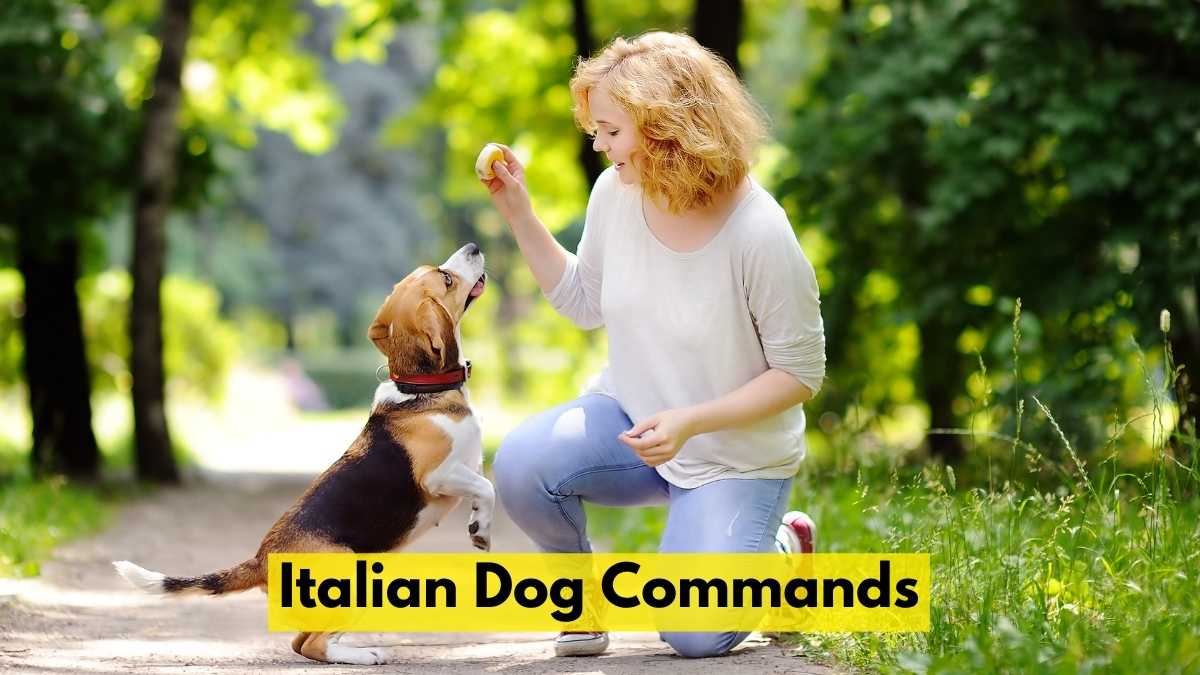Italian dog commands provide an engaging and effective way to train our furry companions. Amidst the array of training options, the importance of incorporating different languages, such as Italian, stands out. Firstly, teaching dogs in multiple languages helps them respond to commands from various family members or even when interacting with Italian-speaking individuals. Secondly, Italian commands offer specific advantages. The melodious cadence of Italian enhances the dog’s receptiveness and makes training enjoyable. The crisp and distinct pronunciation also facilitates quicker comprehension. Embracing Italian dog commands allows for a seamless integration of language nuances, creating a stronger human-canine connection. Let’s explore the world of Italian dog training, its benefits, and how to master this beautiful language for our loyal companions.
Table of Contents
Basic Italian Dog Commands
Basic Italian Dog Commands are fundamental tools in training our canine companions, fostering obedience and strengthening the bond between humans and dogs. Here, we delve into three essential commands and their significance:
A. Sit Command:
The “Seduto” (seh-DOO-toh) command is a fundamental cue to teach dogs to sit on command. Accompanying this verbal command with a corresponding hand gesture and body language helps reinforce the message. When giving the command, hold a treat above the dog’s head and move it backward, encouraging the dog to lower into a sitting position. Rewarding them with the treat reinforces the behavior positively.
B. Stay Command:
The “Fermo” (FER-moh) command is invaluable in ensuring dogs remain in place until instructed otherwise. A clear hand gesture, like holding an open palm towards the dog, emphasizes the command. To reinforce the stay, take a step back and wait a few seconds before rewarding them for compliance.
C. Come Command:
The “Vieni” (VYEH-nee) command calls the dog to return promptly to the owner’s side. Employing positive reinforcement techniques, such as using a cheerful tone and offering treats, encourages a quick response. Begin training in a controlled environment and gradually increase the distance between the owner and the dog to solidify the recall command.
By mastering these basic Italian dog commands, we equip our canine friends with essential skills for better communication and behavior, laying the groundwork for more advanced training. Remember, consistency and patience are key to successful training sessions, resulting in a well-behaved and happy furry companion.

Advanced Italian Dog Commands
Advanced Italian Dog Commands take canine training to the next level, further enhancing their behavior and responsiveness. Let’s explore three essential commands and their significance:
A. Heel Command:
The “Piede” (PYEH-deh) command encourages dogs to walk politely by their owner’s side without pulling on the leash. Proper leash walking techniques and body positioning play a vital role in teaching this command. Hold the leash close to your body, and as the dog walks calmly by your side, reward them with treats and praise. Consistent practice and positive reinforcement lead to a well-mannered, attentive walking partner.
B. Lie Down Command:
The “SDraiati” (s-drah-YAH-tee) command instructs dogs to lie down on command, demonstrating respect and obedience. The approach to teaching this command may vary depending on the dog’s age and temperament. For younger or more energetic dogs, luring them into the down position with treats can be effective, while gentle guidance works better for older or timid dogs.
C. Leave It Command:
The “Lascia” (LAH-shah) command prevents dogs from picking up or engaging with unwanted objects or distractions. Training exercises are essential to help dogs understand the concept of “leaving it.” Begin by presenting a low-value item and saying the command. When the dog refrains from interacting with the item, reward them with a high-value treat and praise.
Mastering these advanced Italian dog commands requires patience, consistency, and understanding your dog’s individual needs. Building on the foundation of basic commands, these advanced cues facilitate a harmonious and enjoyable relationship between dog and owner.
Problem-solving Commands
Problem-solving commands are essential tools in dog training, enabling us to address unwanted behaviors in a constructive and positive manner. Let’s explore two important commands to tackle such issues:
A. No Command:
The “No” (noh) command is crucial for discouraging dogs from engaging in undesirable behaviors. When using this command, it’s essential to strike a balance between firmness and avoiding aggression. Rather than shouting, use a clear and authoritative tone to get the dog’s attention. Combine the “No” command with redirecting their focus onto appropriate behavior and rewarding them for complying.
B. Off Command:
The “Giù” (JOO) command teaches dogs to get off or stop specific actions, such as jumping on furniture or people. When the dog exhibits the undesired behavior, gently say “Giù” and guide them away from the object or person. Redirect their behavior to a suitable alternative, such as sitting or staying, and reward them when they follow the command. Consistent reinforcement of the “Giù” command establishes positive habits and fosters a respectful demeanor.
By effectively utilizing problem-solving commands like “No” and “Giù,” we can correct unwanted behaviors while maintaining a nurturing and respectful relationship with our canine companions. Remember, patience, consistency, and positive reinforcement are key to successful problem-solving training sessions.
Specific Purpose Commands
Specific purpose commands add fun and functionality to our dog’s training repertoire. Let’s explore two exciting commands that serve particular purposes:
A. Fetch Command:
The “Recupera” (reh-KOO-peh-rah) command engages dogs in an enjoyable game of retrieving objects and bringing them back to their owner. To teach this command, start by playing with the dog using their favorite toy. When they pick up the toy, say “Recupera” and encourage them to come back to you. Reward the dog with praise and treats when they return the item. Gradually increase the distance between you and the dog to strengthen their retrieving skills.
B. Speak Command:
The “Parla” (PAHR-lah) command teaches dogs to bark on command, which can be helpful in alerting owners or working as a fun trick. Begin by enticing the dog to bark, then introduce the command “Parla” during the barking. Reward them with treats and praise when they bark upon hearing the command. To balance this command, teach the “Quiet” command by using a hushed tone and rewarding them when they stop barking.
Through these specific purpose commands, dogs can learn new skills, engage in stimulating activities, and strengthen the bond with their owners. Always use positive reinforcement and patience during training sessions to ensure a successful and enjoyable learning experience for both dog and owner.
Unique Italian Dog Tricks
Unique Italian dog tricks add flair and charm to our canine companions’ skillset. Let’s explore two delightful tricks that can impress friends and family:
A. Roll Over:
The “Rotola” (roh-TOH-lah) command teaches dogs to roll over on their backs. Breaking down the trick into manageable steps ensures a successful learning process. Begin by having the dog lie down. Then, entice them with a treat and gently guide them to roll over on their side. Gradually, extend the roll until the dog completes a full roll over. Reward the dog with treats and praise throughout the learning journey to reinforce the behavior.
B. Shake Hands/Paw:
The “Dai la zampa” (dah-ee lah ZAHM-pah) command instructs dogs to offer their paw for a handshake. Incorporate positive reinforcement during training sessions by offering a treat in your hand and saying the command. When the dog places their paw in your hand, reward them with the treat and verbal praise. Consistent repetition of the command will help the dog associate the action with the cue.
By teaching these unique Italian dog tricks, we not only provide mental stimulation for our furry friends but also create endearing interactions that showcase their intelligence and charm. Patience, encouragement, and positive reinforcement are key to mastering these tricks and having a delightful time with our Italian-trained dogs.

Tips for Successful Italian Dog Training
Successful Italian dog training requires dedication and a mindful approach. Here are some valuable tips to make the training process effective and enjoyable:
A. Consistency in Commands and Body Language:
Consistency is key to ensuring the dog comprehends the Italian commands. Use the same words and gestures consistently so that the dog associates them with specific actions. Avoid confusing the dog by using different cues for the same command. Maintain a confident and clear body language to reinforce the verbal commands.
B. Positive Reinforcement and Rewards:
Positive reinforcement is a powerful motivator for dogs. Whenever the dog responds correctly to a command, reward them with praise, treats, or affection. This positive association encourages the dog to repeat the desired behavior, making training more effective and enjoyable for both the owner and the dog.
C. Patience and Understanding the Dog’s Individual Learning Pace:
Every dog learns at its own pace, and patience is vital during training. Avoid rushing the dog or becoming frustrated if they do not grasp a command immediately. Be patient and understanding, providing encouragement and support throughout the learning process. Celebrate even small achievements to boost the dog’s confidence and enthusiasm for training.
D. Regular Training Sessions and Practice:
Consistency and regular practice are essential for successful training. Set aside dedicated training sessions each day, keeping them short and focused. Frequent but brief sessions prevent the dog from becoming overwhelmed and maintain their interest in learning. Additionally, practice commands in various environments to ensure the dog generalizes the skills to different situations.
By following these tips, Italian dog training becomes an enriching experience that fosters a strong bond between owner and dog. Remember that training is an ongoing process, and a positive and patient approach will yield rewarding results in the long run.
Conclusion
In conclusion, using Italian dog commands offers a range of benefits for both dogs and their owners. The melodious sound and distinct pronunciation of Italian commands make them engaging and easily distinguishable for our canine companions. The effectiveness of these commands is enhanced when combined with positive reinforcement, creating a rewarding training experience.
Embracing multilingual training, including Italian commands, opens up a world of possibilities for communication with our dogs. It allows them to respond to commands from various family members and fosters a deeper understanding between dogs and Italian-speaking individuals.
Beyond language, Italian dog training strengthens the bond between owners and their furry friends. Consistency, patience, and positive reinforcement build trust and respect, nurturing a harmonious relationship.
So, let’s embark on this journey of Italian dog training, exploring new tricks, mastering commands, and experiencing the joy of connecting with our Italian-trained dogs. Together, we can create a loving and well-trained companion, enriched by the beauty of the Italian language.
You May Also Like:
Norwegian Dog Commands for Your Furry Friend
The Bubble Theory Dog Training: A Comprehensive Guide for Dog Owners

